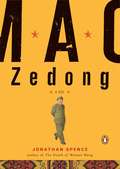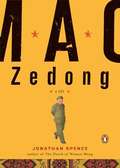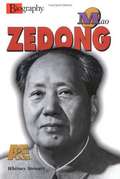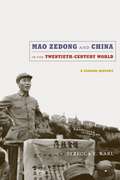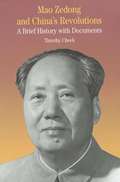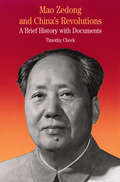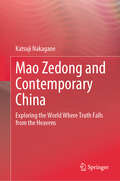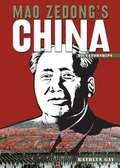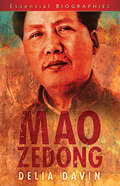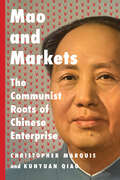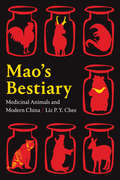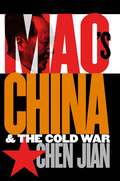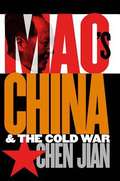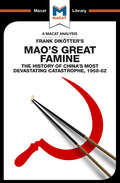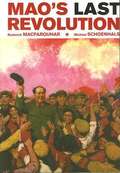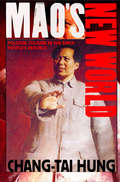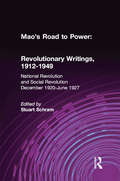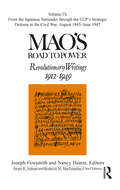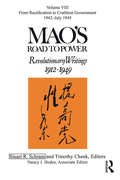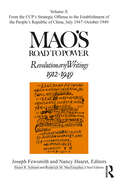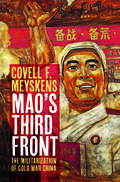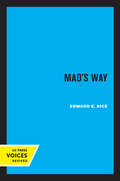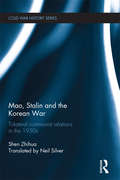- Table View
- List View
Mao Tse-Tung’s Last Great Battle
by Raymond LottaHe proves that true communism is alive, well and as dangerous to oppressors as ever!
Mao Zedong
by Jonathan SpenceHistory of one of the most formidable and elusive rulers in modern history From humble origins in the provinces, Mao Zedong rose to absolute power, unifying with an iron fist a vast country torn apart by years of weak leadership, colonialism, and war.
Mao Zedong
by Jonathan Spence"Spence draws upon his extensive knowledge of Chinese politics and culture to create an illuminating picture of Mao. . . . Superb. ” (Chicago Tribune) From humble origins in the provinces, Mao Zedong rose to absolute power, unifying with an iron fist a vast country torn apart by years of weak leadership, colonialism, and war. This sharply drawn and insightful account brings to life this modern-day emperor and the tumultuous era that he did so much to shape. Jonathan Spence captures Mao in all his paradoxical grandeur and sheds light on the radical transformation he unleashed that still reverberates in China today. .
Mao Zedong
by Whitney StewartMao Zedong was one of the most powerful people in the world during his lifetime. Yet when he was born, China was still ruled by the Qing dynasty. Many people longed for a new China, however, and Mao led the way.
Mao Zedong and China in the Twentieth-Century World: A Concise History
by Rebecca E. KarlThroughout this lively and concise historical account of Mao Zedong’s life and thought, Rebecca E. Karl places the revolutionary leader’s personal experiences, social visions and theory, military strategies, and developmental and foreign policies in a dynamic narrative of the Chinese revolution. She situates Mao and the revolution in a global setting informed by imperialism, decolonization, and third worldism, and discusses worldwide trends in politics, the economy, military power, and territorial sovereignty. Karl begins with Mao’s early life in a small village in Hunan province, documenting his relationships with his parents, passion for education, and political awakening during the fall of the Qing dynasty in late 1911. She traces his transition from liberal to Communist over the course of the next decade, his early critiques of the subjugation of women, and the gathering force of the May 4th movement for reform and radical change. Describing Mao’s rise to power, she delves into the dynamics of Communist organizing in an overwhelmingly agrarian society, and Mao’s confrontations with Chiang Kaishek and other nationalist conservatives. She also considers his marriages and romantic liaisons and their relation to Mao as the revolutionary founder of Communism in China. After analyzing Mao’s stormy tenure as chairman of the People’s Republic of China, Karl concludes by examining his legacy in China from his death in 1976 through the Beijing Olympics in 2008.
Mao Zedong and China's Revolutions
by Timothy CheekWhether one views Mao Zedong as a hero or a demon, the "Great Helmsman" was undoubtedly a pivotal figure in the history of 20th-century China. The first part of this volume is an introductory essay that traces the history of 20th-century China, from Mao's early career up to the Chinese Communist Party's victory in 1949, through three decades of revolution, to Mao's death in 1976. The second half offers a selection of Mao's writings-- including such seminal pieces as "On the New Democracy" and selections from the "Little Red Book"-- and writings about Mao and his legacy by both his contemporaries and modern scholars. Also included are headnotes, a chronology, Questions for Consideration, photographs, a selected bibliography, and index.
Mao Zedong and China’s Revolutions: A Brief History With Documents (The Bedford Series In History And Culture)
by Timothy CheekWhether one views Mao Zedong as a hero or a demon, the "Great Helmsman" was, undoubtedly, a pivotal figure in the history of twentieth-century China, a man whose life and writings provide a fascinating window on the Chinese experience from the 1920s onward. <P><P>Part Mao biography, part historical overview of the turbulent story of China’s Communist revolutions, the introductory essay traces the history of twentieth-century China, from Mao’s early career up to the Chinese Communist Party’s victory in 1949, through three decades of revolution to Mao’s death in 1976. <P><P>The second half of the volume offers a selection of Mao’s writings — including such seminal pieces as "On New Democracy" and selections from the Little Red Book — and writings about Mao and his legacy by both his contemporaries and modern scholars. Also included are headnotes to the documents, a chronology, Questions for Consideration, 12 images, a selected bibliography, and an index.
Mao Zedong and Contemporary China: Exploring the World Where Truth Falls from the Heavens
by Katsuji NakaganeWhat did Mao Zedong bring to China? Mao Zedong, a rare leader who is still regarded as a great hero on the Chinese continent, despite the large number of victims caused by the Great Leap Forward and the Cultural Revolution. He called himself "Qin Shi Huang (First Emperor of Qin)plus Marx". It can be said that he is an entity that combines the power of the emperor and the authority of Marx into one person. This book analyzes the features of Mao Zedong’s thought and philosophy, his understanding of Marxism and class struggle, in particular, his peculiar attitude toward intellectuals, his actions leading to the Great Leap Forward and the Cultural Revolution, which he initiated and involved the entire nation, as well as the analysis of the mechanisms that caused such catastrophes and tragedies. Finally, through these analyses, this book attempts to evaluate Mao Zedong with diverse personalities and his behavior, positive and negative, whether in political, social, economic, or philosophical areas.
Mao Zedong's China (Dictatorships)
by Kathlyn GayIn 1949, Mao Zedong came to power in China after a long and brutal civil war. He and his Chinese Communist Party immediately set out to transform their nation into a Communist state. They seized land from wealthy and middle-class farmers and distributed it to poor peasant farmers. The government also took over ownership of all industries. Citizens who resisted these changes were branded ?counterrevolutionaries, ? and thousands were imprisoned or executed. Within a few years, Mao had turned China into a totalitarian state, controlling all aspects of his citizens? daily lives. In the 1960s, he sought to wipe out what remained of traditional Chinese society by launching the Cultural Revolution. Millions died as the country erupted into spasms of mob violence. Yet, despite the tumult, Chairman Mao remained a revered, almost godlike figure, worshiped by his people. How did he do it? Learn more about one of the most powerful and controversial figures of the 20th century.
Mao Zedong: Essential Biographies
by Delia DavinMao Zedong, first chairman of the People's Republic of China, one of the founders of the Chinese Communist Party, and the architect of the Cultural Revolution, was active in Chinese politics for most of his 82 years, and became one of the most important revolutionary figures in the twentieth century. He spent the 1920s and 1930s struggling to build the Party. After the establishment of the People's Republic, he strove to impose his vision of socialism on his impoverished country, convinced that if the power of the people could be harnessed China could become an economically successful and egalitarian country. The Great Leap Forward which he initiated was, however, a disaster resulting in millions of deaths. Mao used the Cultural Revolution to re-impose his authority, his critics were persecuted and a personality cult was fostered. His Little Red Book sold over 740 million copies. This book is written by an eminent historian and offers the reader a powerful insight into the life and work of this unique man.
Mao and Markets: The Communist Roots of Chinese Enterprise
by Christopher Marquis Kunyuan QiaoA thoroughly researched assessment of how China&’s economic success continues to be shaped by the communist ideology of Chairman Mao It was long assumed that as China embraced open markets and private enterprise, its state-controlled economy would fall by the wayside, that free markets would inevitably lead to a more liberal society. Instead, China&’s growth over the past four decades has positioned state capitalism as a durable foil to the orthodoxy of free markets, to the confusion of many in the West. Christopher Marquis and Kunyuan Qiao argue that China&’s economic success is based on—not in spite of—the continuing influence of Communist leader Mao Zedong. They illustrate how Mao&’s ideological principles, mass campaigns, and socialist institutions have enduringly influenced Chinese entrepreneurs&’ business strategies and the management of their ventures. Grounded in case studies and quantitative analyses, this book shows that while private enterprise is the engine of China&’s growth, Chinese companies see no contradictions between commercial drive and a dedication to Maoist ideology.
Mao's Bestiary: Medicinal Animals and Modern China (Experimental Futures)
by Liz P. CheeControversy over the medicinal uses of wild animals in China has erupted around the ethics and efficacy of animal-based drugs, the devastating effect of animal farming on wildlife conservation, and the propensity of these practices to foster zoonotic diseases. In Mao's Bestiary, Liz P. Y. Chee traces the history of the use of medicinal animals in modern China. While animal parts and tissue have been used in Chinese medicine for centuries, Chee demonstrates that the early Communist state expanded and systematized their production and use to compensate for drug shortages, generate foreign investment in high-end animal medicines, and facilitate an ideological shift toward legitimating folk medicines. Among other topics, Chee investigates the craze for chicken blood therapy during the Cultural Revolution, the origins of deer antler farming under Mao and bear bile farming under Deng, and the crucial influence of the Soviet Union and North Korea on Chinese zootherapies. In the process, Chee shows Chinese medicine to be a realm of change rather than a timeless tradition, a hopeful conclusion given current efforts to reform its use of animals.
Mao's China and the Cold War
by Jian ChenThis comprehensive study of China's Cold War experience reveals the crucial role Beijing played in shaping the orientation of the global Cold War and the confrontation between the United States and the Soviet Union.The success of China's Communist revolution in 1949 set the stage, Chen says. The Korean War, the Taiwan Strait crises, and the Vietnam War--all of which involved China as a central actor--represented the only major "hot" conflicts during the Cold War period, making East Asia the main battlefield of the Cold War, while creating conditions to prevent the two superpowers from engaging in a direct military showdown. Beijing's split with Moscow and rapprochement with Washington fundamentally transformed the international balance of power, argues Chen, eventually leading to the end of the Cold War with the collapse of the Soviet Empire and the decline of international communism.Based on sources that include recently declassified Chinese documents, the book offers pathbreaking insights into the course and outcome of the Cold War.
Mao's China and the Cold War: The New Cold War History
by Chen JianThis comprehensive study of China's Cold War experience reveals the crucial role Beijing played in shaping the orientation of the global Cold War and the confrontation between the United States and the Soviet Union.<P> The success of China's Communist revolution in 1949 set the stage, Chen says. The Korean War, the Taiwan Strait crises, and the Vietnam War--all of which involved China as a central actor--represented the only major "hot" conflicts during the Cold War period, making East Asia the main battlefield of the Cold War, while creating conditions to prevent the two superpowers from engaging in a direct military showdown. Beijing's split with Moscow and rapprochement with Washington fundamentally transformed the international balance of power, argues Chen, eventually leading to the end of the Cold War with the collapse of the Soviet Empire and the decline of international communism.<P> Based on sources that include recently declassified Chinese documents, the book offers pathbreaking insights into the course and outcome of the Cold War.
Mao's Great Famine: The History of China's Most Devestating Catastrophe 1958-62
by John Wagner GivensThe power of Frank Dikötter's ground-breaking work on the disaster that followed China's attempted ‘Great Leap Forward’ lies not in the detail of his evidence (though that shows that Mao's fumbled attempt at rapid industrialization probably cost 45 million Chinese lives). It stems from the exceptional reasoning skills that allowed Dikötter to turn years of researching in obscure Chinese archives into a compelling narrative of disaster, and above all to link two subjects that had been treated as distinct by most of his predecessors: the extent of the crisis in the countryside, and the actions (hence the responsibility) of the senior Chinese leadership. In Dikötter's view, ultimate responsibility for the catastrophe lies at the door of Mao Zedong himself; the Chairman conceived and ordered the policies that led to the famine, and he did nothing to reverse them or limit the damage that was being wrought when evidence for their disastrous impact reached him. Dikötter's ability to persuade his readers of the fundamental truth of these arguments – despite his admission that his access to sources was necessarily limited and incomplete – together with the clear structure of his presentation combine to produce a work that has had enormous influence on perceptions of Mao and of the Great Leap Forward itself.
Mao's Last Revolution
by Michael Schoenhals Roderick MacFarquharThe Cultural Revolution was a watershed event in the history of the People’s Republic of China, the defining decade of half a century of communist rule. Before 1966, China was a typical communist state, with a command economy and a powerful party able to keep the population under control. But during the Cultural Revolution, in a move unprecedented in any communist country, Mao unleashed the Red Guards against the party. Tens of thousands of officials were humiliated, tortured, and even killed. Order had to be restored by the military, whose methods were often equally brutal. <p> In a masterly book, Roderick MacFarquhar and Michael Schoenhals explain why Mao launched the Cultural Revolution, and show his Machiavellian role in masterminding it (which Chinese publications conceal). In often horrifying detail, they document the Hobbesian state that ensued. The movement veered out of control and terror paralyzed the country. Power struggles raged among Lin Biao, Zhou Enlai, Deng Xiaoping, and Jiang Qing―Mao’s wife and leader of the Gang of Four―while Mao often played one against the other. <p> After Mao’s death, in reaction to the killing and the chaos, Deng Xiaoping led China into a reform era in which capitalism flourishes and the party has lost its former authority. In its invaluable critical analysis of Chairman Mao and its brilliant portrait of a culture in turmoil, Mao’s Last Revolution offers the most authoritative and compelling account to date of this seminal event in the history of China.
Mao's New World: Political Culture in the Early People's Republic
by Chang-tai HungIn this sweeping portrait of the political culture of the early People's Republic of China (PRC), Chang-tai Hung mines newly available sources to vividly reconstruct how the Chinese Communist Party (CCP) tightened its rule after taking power in 1949. With political-cultural projects such as reconstructing Tiananmen Square to celebrate the Communist Revolution; staging national parades; rewriting official histories; mounting a visual propaganda campaign, including oil paintings, cartoons, and New Year prints; and establishing a national cemetery for heroes of the Revolution, the CCP built up nationalistic fervor in the people and affirmed its legitimacy. These projects came under strong Soviet influence, but the nationalistic Chinese Communists sought an independent road of nation building; for example, they decided that the reconstructed Tiananmen Square should surpass Red Square in size and significance, against the advice of Soviet experts sent from Moscow.Combining historical, cultural, and anthropological inquiries, Mao's New World examines how Mao Zedong and senior Party leaders transformed the PRC into a propaganda state in the first decade of their rule (1949–1959). Using archival sources only recently made available, previously untapped government documents, visual materials, memoirs, and interviews with surviving participants in the Party's plans, Hung argues that the exploitation of new cultural forms for political ends was one of the most significant achievements of the Chinese Communist Revolution. The book features sixty-six images of architecture, monuments, and artwork to document how the CCP invented the heroic tales of the Communist Revolution.
Mao's Road to Power: Revolutionary Writings, 1912-49 (Mao's Road to Power)
by Stuart Schram Zedong Mao Mao, Tse TungThis projected ten-volume edition of Mao Zedong's writings provides abundant documentation in his own words regarding his life and thought. It has been compiled from all available Chinese sources, including the many new texts that appeared in 1993, Mao's centenary.
Mao's Road to Power: Revolutionary Writings: Volume IX (Mao's Road to Power)
by Joseph Fewsmith and Nancy HearstThe series, Mao’s Road to Power, consisting of translations of Mao Zedong’s writings from 1912 to 1949, provides abundant documentation in his own words on his life and thought as well as on developments in China during the pre-1949 period. This penultimate volume in the series, Volume 9, covers the period from the Japanese Surrender through the Chinese Communist Party’s Strategic Defense during the Civil War, August 1945 to June 1947.
Mao's Road to Power: Revolutionary Writings: Volume VIII (An\east Gate Book Ser.)
by Timothy Cheek Stuart Schram Roderick MacFarquharThis eighth volume covers the period 1942 to 1945 when Mao asserted his status as the incarnation and symbol of the Chinese Revolution and the sinification of Marxism-Leninism.
Mao's Road to Power: Revolutionary Writings: Volume X (Mao's Road to Power)
by Joseph Fewsmith and Nancy HearstThe series, Mao’s Road to Power, consisting of translations of Mao Zedong’s writings from 1912 to 1949, provides abundant documentation in his own words on his life and thought as well as developments in China during the pre-1949 period. This final volume in the series, Volume 10, covers the period from the Chinese Communist Party’s Strategic Offense during the Civil War to the Establishment of the People's Republic of China, July 1947 to October 1949.
Mao's Third Front: The Militarization of Cold War China
by Covell F. MeyskensIn 1964, the Chinese Communist Party (CCP) made a momentous policy decision. In response to rising tensions with the United States and Soviet Union, a top-secret massive military industrial complex in the mountains of inland China was built, which the CCP hoped to keep hidden from enemy bombers. Mao named this the Third Front. The Third Front received more government investment than any other developmental initiative of the Mao era, and yet this huge industrial war machine, which saw the mobilization of twelve million people, was not officially acknowledged for over a decade and a half. Drawing on a rich collection of archival documents, memoirs, and oral interviews, Covell Meyskens provides the first history of the Third Front campaign. He shows how the militarization of Chinese industrialization linked millions of everyday lives to the global Cold War, merging global geopolitics with local change.
Mao's Way (Center for Chinese Studies, UC Berkeley #7)
by Edward E. RiceThis major biography of Mao draws on never before seen documents to reveal surprising details about Mao's rise to power and leadership in China. This title is part of UC Press's Voices Revived program, which commemorates University of California Press's mission to seek out and cultivate the brightest minds and give them voice, reach, and impact. Drawing on a backlist dating to 1893, Voices Revived makes high-quality, peer-reviewed scholarship accessible once again using print-on-demand technology. This title was originally published in 1972.
Mao, Stalin and the Korean War: Trilateral Communist Relations in the 1950s (Cold War History)
by Shen ZhihuaThis book examines relations between China and the Soviet Union during the 1950s, and provides an insight into Chinese thinking about the Korean War. This volume is based on a translation of Shen Zihua’s best-selling Chinese-language book, which broke the mainland Chinese taboo on publishing non-heroic accounts of the Korean War.The author combined information detailed in Soviet-era diplomatic documents (released after the collapse of the Soviet Union) with Chinese memoirs, official document collections and scholarly monographs, in order to present a non-ideological, realpolitik account of the relations, motivations and actions among three Communist actors: Stalin, Mao Zedong and Kim Il-sung. This new translation represents a revisionist perspective on trilateral Communist alliance relations during the Korean War, shedding new light on the origins of the Sino-Soviet split and the rather distant relations between China and North Korea. It features a critical introduction to Shen's work and the text is based on original archival research not found in earlier books in English. This book will be of much interest to students of Communist China, Stalinist Russia, the Korean War, Cold War Studies and International History in general.

